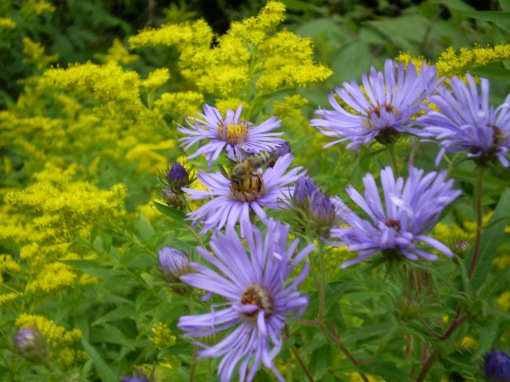
Bees are important pollinators. The insects help to pollinate many of our food crops, the flowers in gardens and parks, and food crops used by native wildlife. In recent years, there has been a noticeable decline in bee populations which has caused some some serious concerns within the agricultural community and home gardeners.
The reasons for the decline are a mysterious disease fatal to honeybees, Colony Collapse Disorder (CCD). mites, loss of natural habitat and pesticide use.
There are some “green” actions which home owners and gardeners can take to help the declining populations. Try to leave some wild areas to provide habitat, discontinue pesticide and herbicide use, and plant flowers rich in pollen and nectar for the bee pollinators. Three good candidate plants to establish for the bees are borage, buckwheat and native wildflowers.
Borage is a hardy, self seeding annual, somewhat uncommon in North America. Borage, often called the “bee plant”, has light blue or pink flowers ,and is a rapid grower; borage is not particularly fussy about soil conditions. A blooming patch of borage will attract hundreds of bees from miles around, both native bees and the all important honeybee.
The seeds are large and easy to plant and germination is usually within a week. It is best to sow the seeds directly in the soil in the spring since it does not transplant well. The following year, the seeds will readily sprout from last year’s crop. If they are in a location where they are not wanted, carefully dig the seedling when it is young, within a week at least, and place it where it is wanted with plenty of water.
Besides being nutritious for the bees, borage leaves are edible and have a cucumber-like taste. They can be chopped and used in salads; or dried and brewed for a tea. The flowers are often used as a decorative item on cakes and pastries, and some freeze the flowers in ice-cubes which are then used for a cocktail drink.
This native plant from the Mediterranean area is reputed to have medicinal qualities. Borage honey is some of the best and is highly prized in some regions. With a blooming patch of star shaped, blue or pink flowers, the buzz from happy bees will be heard dozens of feet away.
Buckwheat honey, well, and pancakes, are more commonly known. Buckwheat, like borage, provides plenty of nectar and pollen for all bee pollinators. Buckwheat, unlike borage, should be sown every year, but it is a simple task. The large seed can basically be just scattered on the ground and barely covered. It germinates quickly, usually within days, and is a rapid grower. If planted for buckwheat harvest, it can be ready in as little as eight weeks.
Buckwheat blooms with small, white flowers which the bees find irresistible. It is a great soil conditioner for an unused patch in the garden. Since it is such as rapid grower, if planted in the spring, the enriched soil can be used for a fall vegetable planting. Buckwheat is also used to help suppress garden weeds since it is such as rapid grower, the weeds don’t have a chance to get growing.
Buckwheat, which could have originated in China, is great for the bees and is healthy for people. It is loaded with many vitamins and minerals. The kernel, called the “groat” can be used for healthy sprouts or ground into a wholesome flour.

Goldenrods and purple asters bloom togther in September and October in one of the best free flower displays in town.
Native wildflowers, a third helpful plant category for the bees, have evolved along with the bees since perhaps the beginning of time. Both need each other for survival; the plants need the bees to reproduce and the bees need the flowers for nourishment. It is a long standing relationship.
Every region has it’s own particular native wildflowers, some unfortunately have been dubbed “weeds”, but they are critical for the well being of the pollinators. Wildflowers can be used effectively in borders, flower gardens and in wild patches of the yard to the benefit of bees and plants, and ultimately, to all of us.
Borage, buckwheat and native wildflowers are important for the bees, and can be an attractive and a great natural addition to the garden or yard. There are other plants which are also helpful and should be considered. But these three, the two “B’s”, borage and buckwheat, and the ancient wildflowers are among the best.